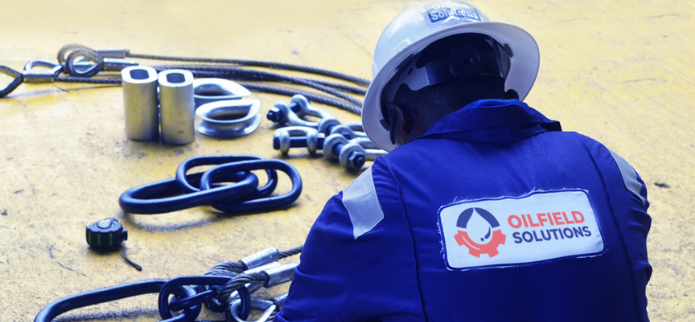‘Slings’ are an indispensable part of lifting operations. They are used in numerous industries from oil and gas to construction and manufacturing to shipping/logistics. In these industries; minor mishaps can have severe consequences; which is why the proper selection and use of slings are of the utmost importance. The safe movement of heavy loads with slings, from one place to the other requires precision, reliability, and stability. To minimize the risk of accidents and injuries, understanding the different types of slings and their uses is paramount. In this article, we will be exploring the different types of slings and their uses.
Lifting slings are the heartbeat of lifting operations and equipment such as cranes, forklifts, or hoists. Designed to securely attach the load to the lifting device, to safely and efficiently position heavy objects; slings are a vital part of everyday lifting operations. They come in various forms, each suitable for a specific type of load or lifting operation depending on the client’s needs.
The three primary types of slings used in industrial lifting are
1. Wire rope slings,
2. Synthetic slings, and
3. Chain slings.
1. WIRE ROPE SLINGS: Wire rope slings are a trusted choice for heavy-duty lifting operations. They are popularly known for their strength and flexibility. Wire rope slings are typically made from multiple strands of wire twisted around a central core. This core can be either steel (Independent Wire Rope Core)or fiber (Fiber core).
The configuration, diameter, and material of the wire strands, along with the type of core, influence the strength, flexibility, and capability of the slings. Wire rope slings come in various sizes ranging from 3MM to over 155MM depending on the client’s specific need.
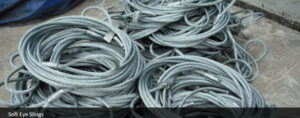
USES OF WIRE ROPE SLINGS
a. Lifting heavy machinery and equipment in manufacturing plants.
b. Hoisting structural steel beams during construction projects.
c. Securing and lifting heavy equipment and tools in mining and excavation sites.
d. Wire rope slings are used extensively in oil rigs and offshore platforms for lifting equipment, pipes, and other materials.
e. In mining operations, wire rope slings are employed for hoisting heavy loads such as ore, equipment, and machinery.
2. SYNTHETIC SLINGS: Synthetic slings are the most versatile type of sling. They are made from strong nylon or polyester fibres and are a popular choice for lifting delicate and unconventionally shaped items. There are two types of synthetic slings namely; Flat Webbing Slings and Round Webbing Slings. Both Flat and Round webbing slings come in an array of colours ranging from purple to green, yellow, grey, red, brown, blue, and orange. These colours help differentiate the ton, type, and capacity of each sling.
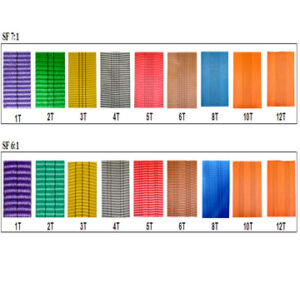
a. FLAT WEBBING SLINGS: flat webbing slings are essential tools for safe and efficient lifting operations. They are lightweight and very durable with a high abrasion resistance. It is ideal for hoisting machinery in factories, securing cargo on logistics vessels, and in construction.

b. ROUND WEBBING SLINGS: round webbing slings are designed with a flexible, tubular construction. These slings similar to flat webbing slings distribute load evenly and minimize potential damage to delicate or fragile loads.
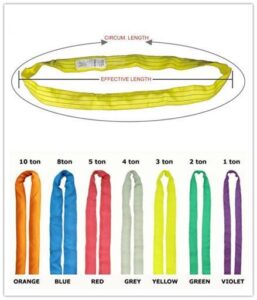
DIFFERENCE BETWEEN FLAT WEBBING SLINGS AND ROUND WEBBING SLINGS
I. Flat webbing slings are constructed from a single layer of woven polyester or nylon fabric, forming a flat, ribbon-like shape while round webbing slings consist of multiple layers of webbing wrapped around a core, resulting in a tubular or round shape.
II. Although both slings offer flexibility, flat webbing slings tend to be more rigid compared to round webbing slings. This makes flat webbing slings easier to handle and manipulate during rigging and lifting tasks whereas round slings are softer and more pliable construction making it perfect for irregularly shaped loads.
III. Flat webbing slings are well-suited for lifting loads with delicate or broader finished surfaces while flat slings are well-suited for lifting loads with delicate or finished surfaces.
IV. Though all webbing slings are flexible; flat webbing slings offer more flexibility for handling and storage due to their flat design and round webbing slings are less flexible when coiling or storing.
USES OF WEBBING SLINGS
 1. Webbing slings are essential for lifting heavy machinery and equipment in manufacturing plants, construction sites, and industrial facilities.
1. Webbing slings are essential for lifting heavy machinery and equipment in manufacturing plants, construction sites, and industrial facilities.
2. They are used for lifting and moving hazardous materials and debris in environmental cleanup projects.
3. Webbing slings are employed in demolition and salvage operations, military logistics and manufacturing, assembly, and maintenance processes.
3. CHAIN SLINGS: Chain slings are made from individual alloy steel links joined together to form a chain. renowned for their strength, durability, and versatility. They are suitable for lifting heavy loads, withstand extreme conditions, and secure hot loads without getting damaged. Chain slings are customizable to single, double, and even quadruple legs featuring various end fittings like master links and hooks.
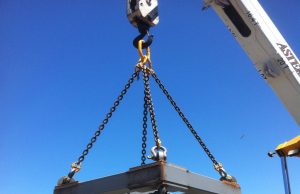
USES OF CHAIN SLINGS
1. Chain slings are used in the lifting and positioning of valves, pipes, and fittings during pipeline installations and maintenance.
2. Chain slings are frequently used for loading and unloading cargo in shipping yards, ports, and warehouses. They are used for lifting ore, equipment, and machinery in the mining industry, agricultural sector, rigging, construction, etc.
3. Chain slings are used for more than lifting operations; they are also greatly used to secure loads to cranes and derricks.
The right type of sling is important to ensure a successful execution of operations, efficiency, and production. Always remember to select the best-suited sling for your lifting operations based on the load type, weight, lifting frequency, and the type of lifting movement specific to the requirements of your lifting operation.
Are you interested in purchasing lifting slings?
Oilfield Solutions Limited provides a wide range of lifting equipments and slings with certified conformity and guaranteed quality for all your lifting and hoisting operations in construction, manufacturing, drilling, rigging, oil and gas.
Reduce risk and accidents today by purchasing the right slings. Contact us at 08076291657 or send an email to delivery@oilfieldsolutions-ng.com to place an order.



